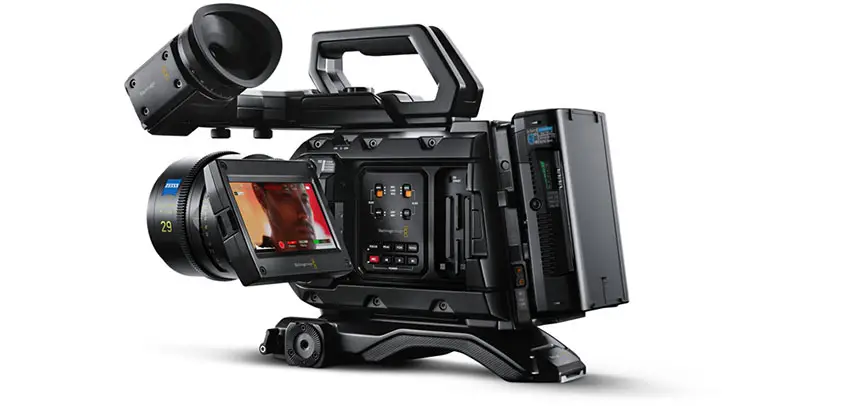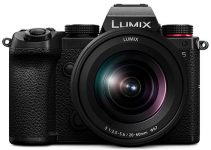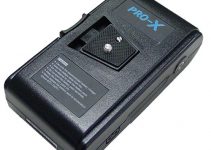12K is now a reality. Blackmagic Design once again is pushing the boundaries of what seems reasonable for relatively affordable cinema cameras with this year’s release of the URSA Mini Pro 12K. I think it’ll still be a little bit before I will get used to the idea that you can just go shoot 12K footage right now with a camera you can get at your local shop.
Perhaps not everyone is even looking to pick one up – 12K is an insane amount of data – the concept and tech deserves a deeper look. In that case we are lucky that Carl Yates from ProAV TV went hands-on with the URSA and went over some of the most important specs.
For the URSA Mini Pro 12K Blackmagic custom designed a Super 35mm sensor that eschews the traditional Bayer filter pattern for a system that features an equal amount of red, green, and blue pixels.
A major advantage of this is improved color accuracy, though considering the extremely high resolution the symmetrical design makes it easier for the camera to effectively downsample to lower resolutions. Without de-Bayering everything runs a bit faster. This means you get reduced rolling shutter and faster shutter speeds.
Another aspect of the camera is Blackmagic RAW, or BRAW. With better compression options and capabilities it makes 12K footage much more manageable. It has even been designed to handle this type of sensor.
As Yates points out, this is perhaps the first cinema camera where the manufacturer has complete control of the entire pipeline. They designed the sensor, developed the codec/raw data, and offer DaVinci Resolve as a full NLE/coloring suite.
Interestingly, the URSA 12K only allows users to record in Blackmagic RAW, so while other NLEs do offer support for it you’ll be best off with Resolve.
You could use an external recorder, but Yates points out you’ll lose many advantages of the camera. The workflow with Resolve appears to be very good anyway. Yates claims they were able to get 12K BRAW files playing back on a 2017 MacBook Pro.
As for body design, the 12K managed to keep the same form factor as the regular 4.6K URSA Mini Pro. Now there is a USB-C port at the rear for connecting an external SSD or the new dedicated unit. It’s a lot of data for 12K, so this is a nice addition.

Image Credit: Blackmagic Design
Yates appreciates that they’ve kept the same body design as the previous version, but still keeps the same issues as that model. He says it’s a little clunky—not exactly unheard of with Blackmagic cameras—and that some aspects don’t feel quite as modern or of as high quality as competing options. Considering the specs and price point it just all makes sense.
Now to actually talk about the core specs. It is now the highest resolution cinema camera on the market. Somehow, Blackmagic even offers decent frame rate options at the highest resolutions. This means DCI 12K at 60 fps and 8K up to 120 fps. That is with full sensor width, too. Cropping in to 2.4:1 can get you 8K up to 160 fps and Super 16mm mode will get 6K up to 120 fps and 4K up to 240 fps. Those are some insane numbers.
Previously, RED was the only real manufacturer delivering cinema cameras with high resolutions and frame rates in raw. Blackmagic is making a real statement with this model. Plus, the new sensor can get full-width readout at lower resolutions in raw.
There is an obvious problem with 12K: data. The URSA 12K when recording at 12K with 5:1 compression hits a data rate that is an astounding 578 MB/s, or 4,608 Mb/s if you want to compare to other cameras easily. It’s a lot. Real-world use puts that at about 14 minutes of recording on a 512GB SSD. That can get expensive really quickly.
Realistically most people won’t be using max quality. Going to 8:1 compression hits 361 MB/s, or 2,888 Mb/s, which sounds much better after looking at the max quality rates. If you want 12K it’s just the price of doing business.
8K gets better still, with 5:1 at 258 MB/s and 8:1 at 161 MB/s. Looking at the C200’s 4K raw for comparison, 8K on the URSA is just a hair above it.
This sounds like a more reasonable option for shooters. For everyday shooting in 4K, the camera drops down to the much easier to handle 65 MB/s (520 Mb/s) in 5:1 and 41 MB/s (328 Mb/s) in 8:1. Most people could do that without any cause for alarm.
And, in the event you need longer recording times there are higher compression ratios available, like 12:1, that will get those data rates down even more. Yates also says that the lower resolution options are practically as good anyway, so there’s no reason to worry about using them. And if you are finishing in 4K, then the reduced quality is practically impossible to see.
The URSA Mini Pro 12K is insane. It also looks like it is doing a good job in managing it. The fact that there are downsampling options available that are more practical to use makes it viable as a long-term purchase if you want greater than 4K resolutions soon and want room to expand in the future. Or even just pull off the occasional shot that needs some serious resolution.
I thought this thing was more of a gimmick or a camera Blackmagic made simply because they could. But now it’s looking more and more like a serious option for many types of filmmakers.
What are your thoughts on the URSA Mini Pro 12K?
[source: ProAV TV]
Order Links:
- Blackmagic Design URSA Mini Pro 12K Cinema Camera (B&H, Amazon)
- Blackmagic Design DaVinci Resolve Studio (B&H, Amazon)
Disclaimer: As an Amazon Associate partner and participant in B&H and Adorama Affiliate programmes, we earn a small comission from each purchase made through the affiliate links listed above at no additional cost to you.



